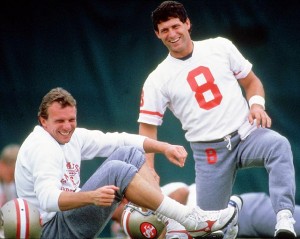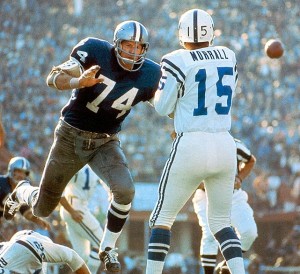by Chase Stuart
on May 16, 2014

That's a pretty good backup.
Determining the best backup quarterback ever is really complicated. Steve Young and Aaron Rodgers backed up Joe Montana and Brett Favre, respectively, but neither Young nor Rodgers morally feel like they belong in the discussion of best backup quarterbacks.
There are a couple of ways to measure how a backup quarterback fares. One way is on a game-by-game approach: i.e., the starter gets injured or pulled, and now the backup is in charge. That’s the sort of thing Frank Reich, at least anecdotally, excelled at. The more interesting, and easier question to analyze, is to take a season-by-season approach. If a quarterback does not start his team’s season opener, he’s a backup. If he does, he’s not.
Using that concept, the name that immediately jumps to mind is Earl Morrall. After all, he led two teams to Super Bowls during seasons that began with him on the bench. But what do the numbers say?
Ironically, my proposed definition excludes what is undoubtedly the greatest season in backup quarterback history: Kurt Warner in 1999. That season may have been a top-three season in quarterback history, but it began with Warner second on the depth chart to Trent Green. When Rodney Harrison ended Green’s season in the preseason, Warner become the starter, which would exclude his ’99 season from this analysis.
And, uh, ironically again, Morrall’s best season is excluded, too. His top year was in 1968 when he won the NFL MVP, but since Johnny Unitas was injured in the preseason, Morrall isn’t labeled a backup by this formula, either. But I do think that the Warner and Morrall examples are rare enough that we can proceed with minimal concern. [continue reading…]
Tagged as:
Craig Morton,
Earl Morrall,
Gus Frerotte
{ }
by Chase Stuart
on April 30, 2014

Morrall in Super Bowl V.
Five days ago, Earl Morrall passed away at the age of 79. His story is well-known to many, but it’s one worth recounting for the uninitiated.
Born in Muskegon, Michigan, Morrall was a star quarterback and baseball player at Michigan State. He made it to the College World Series in 1954 as an infielder, and a year later he guided the Spartans to a 9-1 record as a senior and a victory over UCLA in the Rose Bowl. Morrall was selected by San Francisco with the 2nd overall pick in the 1956 draft, where he sat behind Y.A. Tittle for a year.
In that draft, Pittsburgh used the first overall pick on safety/kicker Gary Glick, who had been a jack of all trades in college, but the team quickly had buyer’s remorse. After the 49ers selected John Brodie with the third pick in the 1957 draft, the Steelers saw an opportunity to acquire Morrall, and did so by sending two future first round picks (and linebacker Marv Matuszak) to the 49ers for Morrall.
Why was Pittsburgh so desperate to trade for him? Because Pittsburgh really needed a passer: the only other quarterbacks on the roster at the time were a pair of 22-year-olds named Len Dawson (yes that Len Dawson), whom the Steelers selected with the 5th pick in the ’57 draft, and Jack Kemp (yes that Jack Kemp). The Steelers knew you couldn’t count on young quarterbacks — the team released a 22-year-old Johnny Unitas two years earlier — which explains the trade with the 49ers. As a reminder, just about everything Pittsburgh did before 1970 was a disaster.
Morrall produced solid numbers as the Steelers starter in ’57, but threw seven interceptions in his first two starts with the Steelers in 1958. Pittsburgh’s head coach at the time was Buddy Parker, who had coached the Lions from 1951 to 1956. Parker was not content to turn the job over to Dawson, so he traded Morrall and a pair of picks to Detroit for his old quarterback, Bobby Layne. [continue reading…]
Tagged as:
Earl Morrall
{ }


